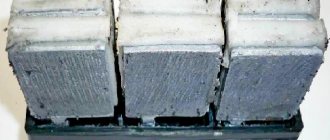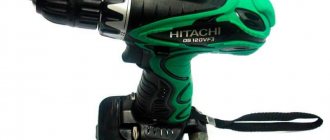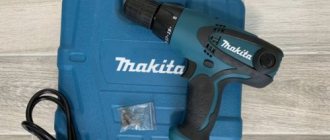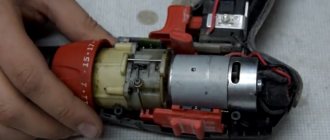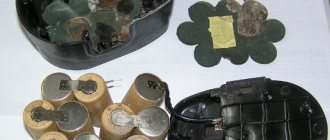When purchasing such a universal and suitable tool as a screwdriver, its owners have various questions during the process of use. Since any power tool of this type is equipped with a battery pack that allows you to work with it autonomously, it is important to know what it really is, how to properly charge the battery and the best time to charge the screwdriver battery. Today, there are a number of practical tips on its use, which may always prove useful.
What you need, more frequent questions that arise for those who are just starting to use a screwdriver:
- how to properly charge a screwdriver battery;
- what to do if the battery does not hold a charge, does not charge at all;
- how to charge a screwdriver without a standard charger;
- and, this is what the average battery charging time is.
Correctly charging a screwdriver: how to do it better
There are several common rules for charging a screwdriver battery so that the tool uses its entire potential resource.
When you purchase a new tool, do not forget that you need to charge the battery well before using it for the first time. Any batteries, if they lie in a warehouse or store for a long time, tend to discharge.
If your screwdriver is equipped with a battery made of Ni Cd (nickel-cadmium) parts, “pump” them using a three-time working version of charging with the next discharge in order to remove the “memory effect” that is typical for Ni Cd batteries and increase their level capacity to rational.
If your screwdriver has lithium-ion batteries, it is not necessary to perform such a “pumping” on them, since the “memory effect” is not characteristic of them: these are more modern batteries.
It is necessary to charge the battery at a suitable natural temperature. The best temperature characteristics when charging the screwdriver battery are not lower than 10°C and not higher than 40°C. During charging, you should not leave the battery unattended forever to avoid overheating and overcharging. Although, if the standard charging of the tool is equipped with an indicator for monitoring the entire process, the device will automatically “finish” it when it is needed.
It is not recommended to leave the battery pack in the charger forever. If the screwdriver is not used that often, it is better to remove the batteries when using it and store it separately from it. If there is a passage where the batteries are left unused for a long time, pay attention to keeping them in a charged state by “recharging” them once a month for 25-30 minutes .
As we know, the battery pack is either nickel-cadmium or lithium-ion. Ni Cd batteries can be stored at any charge level . Their main main advantage of gaming slots is that they are not afraid of the deepest discharges. In order for them to work perfectly after a long break, they should be “pumped” three to four times as usual. The “pumping” time, on average, is 3-4 hours , during which you can work with a screwdriver in normal mode. It is better to keep control when using a screwdriver so that the Ni Cd battery is not partially discharged, but one hundred percent. This will help her not accumulate that “memory effect”.
If the battery power supply of your instrument is equipped not with nickel-cadmium, but with lithium-ion batteries, their main “plus” is that they do not have a “memory effect” . But it is recommended to monitor their charge level more carefully.
For which the design is intended, if a screwdriver with lithium batteries is not used for some time, they must be charged from time to time.
They do not adore the deepest discharge. If lithium batteries are deeply discharged, the protective controller inside the battery pack will operate. To prevent this from happening, make sure that the batteries are charged at least 50 percent.
: Assembly
Next, our task is to properly insulate everything. I used ¾ roll of duct tape for this. First, I wrapped each of the connections so that no metal parts protruded. Then I wrapped everything together so that the terminals did not touch each other.
When I assembled the screwdriver body, I wrapped the wires at the exit from the body with electrical tape for insulation and fixation.
Congratulations! Now it doesn’t matter whether you forgot to charge the screwdriver or not and how long its charge will last. With such a tool you can work for a long time, even where there is no electricity at all.
Despite how comical the method is, it really works. Only for lighting, we will not use the screwdriver itself, but only the battery from it. It is much smaller in size, not to mention capacity and voltage, but it is quite capable of starting a car with a dead battery.
How to CHARGE a car battery using a screwdriver
from a screwdriver
MAKITA.
We measure the charging
amperes
of a car
battery.
The average time it takes for the battery to be fully charged is 7 hours . And if the battery just needs to be recharged, it can be left on charge for 30 minutes. Although, in the case of Ni Cd batteries that have a “memory effect”, frequent and short recharging is not recommended.
There are several types of chargers for screwdrivers, depending on their scope of application. An ordinary charger , as a rule, is included in the package of household power tools. The battery charging time with its help varies from three to seven hours .
There are also powerful pulse-type chargers that come with professional tools. How long does it take to charge a screwdriver battery with such a device? “Pulsers” can fully charge the battery within an hour , which is their undeniable advantage. However, the cost of such a tool is, of course, much higher.
Other power supply methods
Car charger
When looking for a solution to the question “is it possible to connect a screwdriver to a charger?”, you can stop at charging with a car AK unit. modules with manually adjustable current and voltage are applicable. The connection is not difficult at all. It is enough to connect the input channels of the instrument motor with the contacts of the car charging installation.
general recommendations
All of the above methods include one step that unites them. disassembling the power module housing. If the frame is secured with bolts, then this is NOT a difficulty; fastening with glue requires carefully opening the seam by tapping the gap with a hammer and inserting a knife into it.
When installing, observe the direction of voltage. it does not have to be supplied to battery c. Therefore, the module is mounted parallel to the supply contacts, and a diode illuminator with a certain power is built into the positive line.
Summary: to the question “can a screwdriver work from a charger” there is a positive answer, and several solutions, but caution, some scientific knowledge and dexterity are required.
What to do if the battery does not charge or does not hold a charge
In this case, there are few options: either the cause of the malfunction lies in the charger, or the screwdriver itself is acting up. Also, the battery pack may eventually exhaust its resource and need to be replaced. In order to find out the reason, it is necessary to carefully examine both the tool itself and its battery along with the charger.
Often the reason for poor battery charging is that the contact between the screwdriver and its charger weakens due to the extension of the terminals. To fix this problem, you just need to disassemble the charger and carefully bend its terminals back.
Don’t forget about such a common problem as oxidation of the metal parts of the battery and charger itself. The constant ingress of construction dust and dirt also contributes to a weak flow of charge current from the charger to the battery: the tools charge less well. It is important not to forget to care for all components of the tool in order to prevent deterioration in its performance by wiping the metal contacts and clearing them of dirt.
If the battery itself is dead, you can try to “boost” it, as is usually done in the case of nickel-cadmium cells. If this does not help, you will have to either change the battery pack completely or partially replace its elements.
Typically, any screwdriver is equipped with two identical batteries. If one of them fails, if desired, you can assemble one working battery out of two, if the capacity has become smaller in both. After one working unit is assembled from two blocks, you must remember to equalize the capacity of the elements by “pumping” the battery with several charge-discharge cycles for 3-4 hours.
You can also try to “cheer up” the batteries individually. To do this, the weakest of them should be charged with high currents, after which the battery should be put back together and charged as usual.
This method sometimes works with nickel-cadmium batteries. “Spot” recharging with high currents should last no more than 3-5 seconds , and it is advisable to avoid severe overheating of the element in order to avoid its destruction.
How to start a car from a tow or pusher
The classic, one might say, old-fashioned method, when the engine is started by accelerating the car and engaging the gear. An injection engine can be started in this way only if the battery is not fully seated and its charge is sufficient for the fuel pump to pump fuel from the tank into the system.
What you will need
- Donor car with a working battery.
- Starting wires with "crocodiles".
Unless trouble overtook you in a deep forest, there should be no problems with the donor car. But with a set of starting wires it is more difficult: if you do not carry one in the trunk, you can only hope that the driver who comes to your aid will be more prudent.
Read also: The secret of the name. Meaning of the name. Elena
What you will need
The advantage of starting chargers is that they are completely autonomous. Apart from the booster itself, nothing else is needed to start the car. The downside is the relatively high price of gadgets.
Non-standard methods for charging a screwdriver battery
It also happens that the “native” charger from a power tool is either lost or fails, and purchasing the same one is very problematic. Many people ask whether it is possible to properly charge the battery by connecting it to some other power source.
Read also: Where are the ohms on the multimeter?
Of course, this can be done. And such charging methods will not cause any harm to the battery if you are thoroughly familiar with the characteristics of the tool itself and any other charger that can serve as an alternative power source for the battery.
In order to select a suitable alternative charger for your screwdriver, you need to know its voltage and capacity. They are usually indicated on the outer body of the instrument. You should also pay attention to the polarity. It may vary depending on the manufacturer. This is very important for correctly connecting the battery to the charger.
Which charger is suitable is determined as follows. For example, we have an 18-volt screwdriver with a battery capacity of 2 Ah. This means that the charger must be capable of delivering the same voltage, and a power of 200 milliamps per hour will be sufficient - since fully charging such a battery takes a long time . It is better to use a charger with the ability to regulate the current, charging the battery for 6-7 hours .
To supply current to the battery, you can use small crocodiles. And to ensure good contact, they can be additionally secured using metal wires.
If possible, try performing a car memory. It is important to remember that the voltage in this case should be set to the minimum. Determine the polarity of the battery and charger (as already mentioned, it may be different).
Then connect the terminals from the car charger directly to the battery. Sometimes, for optimal contact, it is also necessary to use additional “fixers” in the form of paper clips or flexible metal plates.
After such simple manipulations, all that remains is to plug in the device and carefully monitor the charging process. To begin with, 15-20 minutes , and when the heat transfer in the charged screwdriver battery increases, the charger should be turned off.
Recently, replacing the batteries in a screwdriver from cadmium to lithium has become very popular, especially among professional craftsmen who use a screwdriver regularly. The battery charging time in this case will also depend on the type of charger. If you have a regular “standard” charger, the battery can charge from 3 to 7 hours . And if you have the opportunity to purchase a modern pulse charger, a little over an hour to get the battery into working condition.
A screwdriver is one of the most popular tools used by professionals and amateurs. Using corded screwdrivers is not always convenient, especially if you are away from 220 V. With a cordless tool, this problem is solved; you can move freely with it without dragging the cord behind you.
One of the main elements of any cordless tool is the battery, which ensures autonomous operation. But how should you charge the battery correctly so that it lasts as long as possible? Further details in the article.
Connecting to an external power supply
An external battery is used when compact elements are unavailable or continuous operation of the tool is required.
Cordless screwdriver connected to external power supply
It is worth remembering the steps during disassembly or taking photographs, since intervention and alteration of the electrical circuit of the screwdriver will be carried out, assembly will need to be done exactly in the reverse order.
How to power a screwdriver while maintaining its autonomy
There are situations when you have to work in the absence of electricity. to power a screwdriver without having a 220 network, using several available methods. In such cases, if battery is faulty and alteration from the mains is not possible, there are several ways to operate the impact wrench:
- Replace the battery cells inside the battery with new ones purchased from radio parts.
- Using an external battery-type power source, such as a UPS battery.
- Connected and powered by car battery.
READ How to cut glass in a circle
It is important to remember that any alteration requires technical skills and compliance with safety regulations.
Types of batteries
In order for the battery to serve for a long time “like a clock,” you must first read the instructions included with the device. It should be noted that screwdrivers differ not only in price, power, manufacturer, but are also divided into professional and semi-professional. Accordingly, batteries will also have different prices, quality and charge capacity. Professional types are equipped with more capacious power supplies, which will cost a level more, but will also work longer than conventional ones. Manufacturers use various batteries in the manufacture of their devices, each of which has certain parameters and features that should be taken into account during charging. Batteries for screwdrivers can be classified into the following types:
1. Lithium Li-Ion
They are considered the most powerful batteries. They charge fairly quickly, and there is no memory effect at all. Recharging this type of battery is as easy as shelling pears. There is no need to recharge it after it is completely discharged; you can recharge it as needed. The high cost and intolerance to low temperatures discourage many people from purchasing, so they are not in great demand. Batteries should be charged at temperatures between 10 and 40°C. If the battery becomes hot during charging, it must be cooled to avoid further damage.
2. Nickel-cadmium Ni-Cd
The nickel cadmium battery has compact dimensions and large capacity. By following the included instructions, they can be recharged more than 1000 times. There is a memory effect; if you charge it before it is completely discharged, this can reduce the energy capacity. Before first use, you need to charge and discharge the battery at least three times. In the future, it is also recommended to completely discharge and charge the device, this will make it possible to bring the capacity to the required operating condition. The same rule applies when storing the instrument.
3. Nickel metal hydride Ni-MH
They belong to the newest generation of batteries, for this reason, the memory effect is somewhat weaker than the previous type, which is a definite plus. The disadvantage of NMGB is the highest self-discharge current. In order for the battery to function for a long time, it must be kept charged. If the screwdriver is not used for a long time (about a month), it must be completely recharged.
As you can see, each battery is endowed with characteristic features, taking into account which you will be able to charge the screwdriver correctly.
Discussed
- Alexander to What happened to the RAF plant, the most popular minibus of the USSR.
Small-scale production of buses operates on the territory of the RAF, for some reason only for the city of Jelgava. - Alexey to What happened to the RAF plant, the most popular minibus of the USSR,
here it is the most famous model - Nodar to The third pen in a canister: why is it secret and why is it needed at all?
And at the beginning of the 90s I invented an improved canister - the shape was designed in such a way that there was no need for a tube... - Leonid to Environmental regulations make replacing the Citroen C1 “virtually impossible”
wow! Interesting - alex k Rating of the most reliable cars with mileage from 5 to 10 years in Russia in 2022,
what are the harsh off-road conditions like for the Duster??? it just won’t get there, it’s a crossover.
Features of charging of one type or another + (Video)
The initial charging of the screwdriver is considered a very significant factor, since it determines whether the full charge capacity becomes active or not. Any type of battery has its own characteristics of primary charging. The process of recharging a nickel-cadmium battery is somewhat complicated. Initially, it needs to be recharged three times in a row, and so that the charge capacity remains full.
It is recommended to completely discharge the nickel-metal hydride type for the first time, and also fully charge it. The complete charging/discharging cycle is repeated 4-5 times, then you can safely charge and discharge the battery regardless of how full the container is.
There are no special rules for lithium-ion; the capacity remains unchanged for a long time.
Advice! Do not allow the power supply to overheat above 50 degrees.
Is it necessary to modify the screwdriver?
When the battery no longer holds a charge, the indispensable mechanical assistant turns into a useless tool. It is not profitable to buy another battery , because the cost of a battery can sometimes reach up to 50% of the price of a new tool. Therefore, every zealous owner begins to think about the issue of converting a screwdriver to power from the mains.
You can try to restore the battery characteristics, but this will be a temporary solution. Anyway, in the future the device will quickly discharge. Do-it-yourself conversion to power a screwdriver from a 220 V network is the best option for restoring the functionality of the equipment. What does this solution provide:
- the device can continue to function fully;
- there is no need to use batteries that require charging;
- The torque of the equipment does not depend on the state of charge of the battery.
The only disadvantage is the dependence on the length of the power cord and the availability of an electrical power source.
What is the optimal amount of time to charge?
The recharging period is usually indicated in the device instructions. In most cases, the device has a special indicator that helps you understand how long you still need to charge. Once charging is complete, turn it off to avoid damaging the batteries. The average charging time for a screwdriver will be from 30 minutes to seven hours. The longest period is for Ni-Cd with a voltage of 1.2 V, feeding with a current of 250 mA for approximately seven hours.
There are also two types of battery chargers: regular and pulse. Standard charging is most often included with non-professional tools; the charge lasts about 3-7 hours. The pulse device is designed for professional models and is capable of powering the battery in a maximum of 1 hour.
Tip: The Interskol screwdriver is distinguished by its versatility; in addition to its main function, it can also be used as a drill.
Making a Transformer Coil
There is another way to upgrade the device into a network device. It involves making a portable power supply. A flexible cable is connected to the screwdriver, on the other side of which there is a plug.
True, you will have to make a very special power supply or use a ready-made transformer, which is equipped with a rectifier. Any kind will do, the main thing is that its properties coincide with the parameters of the tool.
transformer coils at home
. In addition, there is an option to simply make a mistake in the number of turns and the choice of wire diameter; you should not do this. There is a lot of unnecessary modern technology, the design of which requires, of course, the necessary transformer. You just need to choose the right one and make a rectifier here.
Semiconductor diodes are used for soldering the rectifier bridge. It is important that their characteristics coincide with the device.
Should I charge it before long-term storage?
Haven't used your screwdriver battery for a long time? Experts give the following recommendations.
- Before storage, nickel-cadmium For long-term storage, you need to carry out 3-5 full charging/discharging cycles.
- Nickel-metal hydride batteries have a higher self-discharge rate, unlike previous elements. Experts advise keeping them charged, and after a long break, leaving them to recharge for a day. The capacity decreases after 200-300 charge-discharge cycles. Partial discharge is allowed for this type.
- Lithium-ion batteries are distinguished by the complete absence of the “memory effect”. The battery can be charged whenever you want. It is not recommended to completely discharge them, as this may disable the protective circuit. They are equipped with special controllers that, at high temperatures, turn off the element to prevent overload. You can store the cell charged only 50%.
Read also: Milling cutter rotation speed formula
What to do if the battery does not charge? + (2 Videos)
The reason may lie in either wear or tear of the device. It often happens that the contacts between the terminals of the charger and the battery are broken. Then you can disassemble the “charging” yourself and bend the terminals.
As you know, all contacts oxidize and become dirty over time, and for a screwdriver with a charger this is no exception. Usually expressed in a significant reduction in charging time, as well as the duration of activity of the power tool. To eliminate the oxide, you need to carefully wipe the contacts with a special substance or, in extreme cases, alcohol.
Very often, nickel-cadmium batteries lose their capacity, especially when it comes to non-professional models. Experienced users prefer to overclock such batteries. First, the battery pack is disassembled and problem areas are identified.
Then they need to be recharged. It is better to immediately use a higher current than expected, and then discharge again. If the electrolyte is still present in the Ni-Cd, the procedure can restore the power supply.
And some experts even use car chargers to recharge the battery.
When the battery unexpectedly dies before an important trip, it is not always possible to connect the original charger. If the problem is not solved, you will have to pay for the services of a mobile car service or look for the required memory in stores. But if you wish, you can use improvised means to charge the car battery by charging it with a screwdriver. In the garage there will probably be a charger from an old cordless drill that can still be of service. Is it possible to charge a car battery by charging from a screwdriver? First, it’s worth considering how a standard car battery charger works. This is a converter that recharges the battery from an external energy source. The simplest design consists of two parts, one of them is a diode bridge. It converts alternating current into pulsating current. The second part is a 220 Volt step-down transformer, which reduces the current resistance of the electrical network.
Charger for car battery The voltage entering the charger is converted from alternating to direct - 15 V. When the charge level drops, the density of the electrolyte decreases. The color of the indicator on the lid also indicates a lack of power. Theoretically, you can charge the battery using a charger from a screwdriver. But you cannot be sure that the charger will definitely fit and that the built-in protection will not work.
Charging for a screwdriver Specialized chargers are distinguished by the presence of adjustment of current and voltage. Therefore, their use is more effective and safe. In the absence of specialized equipment, it is advisable to charge the battery with a lower current, albeit for a longer time. What batteries can be charged in this way? The average charger for a cordless drill has 12-20 V. But the charging current is about 0.4 A, and for fast recharging you need 20 -30 A. However, it is better not to subject the battery to such loads. It can get damaged and quickly fail, so -0.4 A is quite enough. The voltage at the charger terminals should be 10 percent higher than that available at the battery contacts. It is necessary to disable the protection system that analyzes charging time and temperature. Then the device works like a regular current source. You should be prepared that due to the difference in current strength, the charger may burn out. For which batteries is charging from a screwdriver suitable? Like standard chargers for motorists, it is compatible with acid batteries. The standard parameters of most chargers from cordless drills are a voltage of about 14.5 V. The current is from 2.5 to 2.7 A. For comparison, specialized chargers for car batteries have a current 2 times higher - 5 A. You need to make sure that the battery is really discharged. It is easy to check the electrolyte level by opening the filler plugs. In normal condition, it covers the plates; the presence of foreign impurities is unacceptable. Also, there should be no cracks or punctures on the body. If a crack has formed on the case, then the electrolyte has already leaked out, and it is useless to charge a damaged battery. Which batteries cannot be charged in this way? For gel models, the method will not work, since they can withstand a maximum voltage of 14.2 V. For an average screwdriver, this parameter is usually at least 14, 5 V, so gel batteries can simply burn out. It is also important to remember that a certain type of protection is installed in the memory for cordless drills. Only if it is possible to bypass the protection, the driver will be able to charge the battery. How to bypass the protection The socket to which the screwdriver battery is connected contains four terminals. Two of them are negative and positive. The other two terminals go to the relay for protection against short circuits, overheating, and other things. To bypass the protection and not have to deal with the electrical circuit, you can use an unnecessary battery from a drill.
Screwdriver battery disassembled. The screwdriver battery is removed from the housing. The small white plastic box will say that it is a thermal protector. This element, along with the black wires, must be desoldered and soldered to the terminals of the charger. Now the white and black wires are soldered to the protection, observing the polarity. When connecting a battery or other devices, the indicator should show that charging is working normally. If you just turn on the charger, it will blink, indicating that you need to add a battery. That is, the blinking will disappear and the red light will remain on. When the battery or other device is fully charged, the green light should light up.
An example of a diagram for connecting the charging of a screwdriver to a car battery. To charge a car battery, a wire is brought out from the side of the case. You need to connect the terminal blocks, and then connect the wire to the power supply. Otherwise, the protection system will work and charging will not start. The positive and negative wires are connected to the corresponding terminals of the car battery. If the charger is working properly, it should not overheat or melt.
Connecting terminals to charging a screwdriver How to charge a car battery by charging a screwdriver This method is suitable for those who know how to make solders to circuit boards and are ready to remake the charger. Below is an example of disassembling the Makita DC 1440 charger. First, check the voltage on an uncharged battery. You also need to remove the plastic cover.
Then unsolder the drill battery stand. In this case, 4 pins will remain in place of the stand.
We need to see where the pins went. It is convenient to use a ready-made diagram, but it is difficult to find it on the Internet. Therefore, you will have to figure it out on your own. When viewed from the corner, the first contact has a positive charge. The second is a thermal breaker, the third is a negative charge, and the fourth is a thermistor. The thermistor is shorted to ground.
First, instead of a thermistor, a regular resistor is connected.
The second and third legs from the corner need to be soldered together. This is a thermal breaker and a minus.
You need to set the voltage. By default, the zener diode is set to 27 Volts, which is the output.
It is necessary to connect two zener diodes in series at 3.9 and 9 Volts. The output will be 14.65 V. To make charging suitable for different batteries, you need to add a protection circuit. In this case, it is necessary to bypass the native scheme.
Next, the charger is plugged into the outlet. When voltage appears in the network, you will need to look at the output voltage. It should be 14.5 Volts, this value is enough to charge a car battery.
The device is connected to a load, which can be a 21 Watt light bulb or approximately 2 A.
The light should light up and the voltage will be displayed on the multimeter screen. If it is a little less, for example, 14.36 V, this is not a problem. The charger will still work.
A simple way to recharge the battery using a screwdriver. The described method allows you to charge the battery without redoing the charger. But weak currents will be used, designed for a low-power cordless drill. Therefore, it will take longer to gain starting power than using the previously described method. To start charging, the charger is connected to the mains. It is connected to the battery using terminals, while observing the polarity.
When connected, it may flash green and red, this indicates that the battery is faulty. If the process is proceeding normally, the charger operation indicator light should gradually turn red.
Read also: How to wind toroidal transformers video
How long does it take to charge, and what does this time depend on? It will take at least 2-3 hours, in this case the charge will be enough to start the car engine. You can charge the battery completely, but it will take 8-14 hours. When the device is completely discharged, it takes a minimum of 15 hours to fully charge before it is fully restored. If you use a low voltage charger, it will take longer to charge. To get more accurate numbers, you need to take into account the battery capacity.
In about 2 hours the battery should reach its starting capacity. You can check whether the charge level has changed by measuring the voltage. The numbers on the multimeter screen need to be compared with the readings in a discharged state. If it was about 16 V, and it became 1-2 Volts more, then everything is working fine.
After carrying out the manipulations, check the charge level again. To do this, connect the load plug or simply connect the battery to the on-board network. If the starter spins, then the operation was successful. What precautions are there in this charging method? During the charging process, you should not heavily load the network.
Otherwise, plugs may fly out, especially if the wiring in the apartment or garage is old. When the voltage is higher than required, it is recommended to connect one or more light bulbs to the charger. They will take on part of the energy, which will help protect against overload. It is important to maintain polarity; if you mix up the plus and minus, one of the devices will burn out.
When the starting capacity is reached, it will be possible to start the engine, and during the trip the battery will be recharged from the generator. But it is better not to charge it while it is connected to the on-board system with terminals. Otherwise, there is a possibility of damage to the car systems.
What mistakes can be made when recharging the battery? If you charge with a voltage of more than 14.6 Volts, overcharging may occur. The likelihood of failure is especially high if an incompatible memory is used frequently. As a result, the electrolyte may boil away and the battery may overheat. It is important that a light bulb or resistor is connected to the circuit.
If there is no ballast load, the likelihood of failure increases. You should also not begin operations without measuring instruments. You will need a voltmeter and an ammeter, which can be replaced with a multimeter.
It is recommended to integrate a light bulb into the charging circuit to reduce the likelihood of overload. We must not forget about the built-in protection system. Therefore, before connecting the battery, it is better to check its functionality by connecting some electrical appliance. It could be a headlight bulb or an old electric motor.
In some cases, it is impossible to disable the protection without having in front of you the electrical circuit diagram of the charger board. After modification, the screwdriver charging may no longer turn off automatically when fully charged. You will have to control the process yourself to avoid battery damage. When recharging, hydrogen and oxygen begin to be actively released from the electrodes, which is fraught with an explosion. Using an electrical device for purposes other than its intended purpose, a person acts at his own peril and risk.
People without experience in handling electrical appliances should not engage in such work. It is necessary to remember about safety precautions, for example, charging batteries near an open fire or explosive substances is prohibited. Is it possible to charge a car battery by charging a phone or laptop? Not everyone at home has a drill with a charger, which is not a pity to redo. Power supplies for smartphones, laptops and other devices are not intended for use with batteries.
But as a last resort, you can choose this option. This method should not be used repeatedly, since there is a high probability that the charger will burn out. The voltage at the terminals should be less than the voltage at the outputs of the charger.
For example, for a 12 Volt battery, you need to choose a charger whose voltage will be at least 2 V higher. But for a smartphone charger, this parameter is usually no higher than 6 Volts, and for a PC power supply - from 3.3 to 12 V. For laptop chargers, the voltage is usually higher, it can be 19 Volts. These will be useful to the motorist in the absence of the original charger.
When connecting, a short circuit may occur, as a result of which the power supply, battery, or both devices will fail. Perhaps the protection will work and the current simply will not flow to the battery. However, these restrictions can be circumvented.
Connection diagram for charging a laptop to a battery. Then connect the charger from the laptop and turn off the protective system. To do this, wires are connected to the plus and minus of the battery. Then the wires are connected to the charger, also observing the polarity. To avoid creating an overload, connect a light bulb from the headlight. It will take over some of the energy from the power supply.
Charging the battery from a laptop charger You can see the characteristics of chargers suitable for car batteries in the table:
| SHARE: |
| Alternative chargers for charging a car battery | |||||
| View | Voltage | Current strength | Compatible with car battery | Is it suitable for permanent use? | Connection features |
| Charging from a screwdriver | 8-20 Volt | 2.5-2.7 A | Great fit | Fits | Requires disabling protection, possibly re-soldering |
| Charging from a laptop | 15-20 V | 3.5-6.3 A | Possible overload | Not recommended | It is necessary to disable the protection by connecting an additional load |
| PC power supply | 0.3-12 V | 3.16-7.9 A | Longer charging process | Not recommended | You need to disable the protection by switching the wires |
| Charging a mobile phone | 5-12 V | 1-2.1 A | Longer charging process | Not recommended | It is necessary to disable the protection by connecting an additional load |
| Original battery charger | 14.2-20 V | 5 A | |||
Useful video on the topic:
Why remake a cordless screwdriver?
Why remake a screwdriver and when does the need arise?
If you are reading this article, you have probably already appreciated all the convenience of this tool. Without unnecessary wiring and at any time, you can use it even in the most inaccessible places, until the battery runs out. This is the first drawback of the screwdriver. The cheaper the tool, the faster its battery will exhaust its charging cycles.
Here is the second drawback. And you must understand that the manufacturer saves just as much as you do, and there is nothing unusual about it. Buying a new battery in terms of costs is practically no different from buying a screwdriver, but there is a way out, and now we will look at options for converting a screwdriver from battery to mains power.
There are several ways to convert a screwdriver from a cordless one to a mains one:
- using a laptop charger;
- using a PC power supply;
- using a car battery;
- using a power supply from halogen lamps;
- using a Chinese 24V power supply board.
